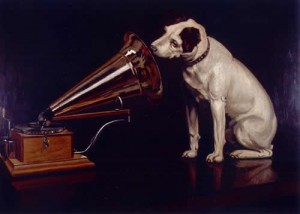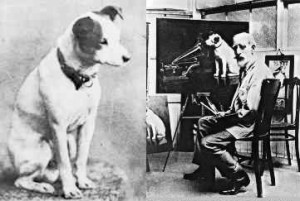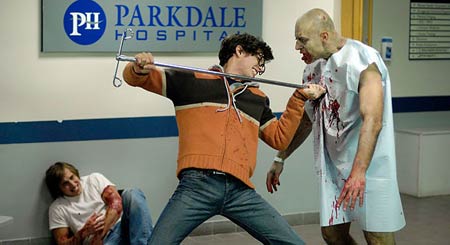Descendants of Wolves
February 2, 2008
Professor Robert Wayne of the University of California plus and eight-person research team. Took mitochondrial DNA samples from 162 wolves and 140 dogs North America, Europe, Asia and the Arabian peninsula. Mitochondrial DNA is inherited from mother to child. It is especially suited to analyze genetic lines that result from mutation over long periods. Dog and wolf DNA differ by only 12 mutations; dogs and jackals and prairie wolves differ in 22 places. This proves that contemporary dogs are descended from wolves exclusively. The split between dogs and wolves occurred around 135,000 years ago, about the same time as our own species appeared, Homo sapiens. However canine varieties that had a skeletal structure different form wolves show up around 14,000 to 20,000 years ago. The belief today is that the pre-canine ‘tame’ wolves differed at first only behaviorally from their counterparts in the wild.
– from If Dogs Could Talk; Exploring the Canine Mind by Vilmos Csányi, translated by Richard E. Quandt, North Point Press, Farrar, Straus and Giroux, New York, NY, 2005. Originally published in 2000 by Vince Kiadó Kft., Hungary
How is your Dog’s Mind Activated?
February 2, 2008
“I believe that it is characteristic of the minds of dogs that they can think only about something that we activate in their minds: a ball, a leash, a few words, and the dog’s mind goes to work full steam. If everybody is busy with something else, the dog lies down, snoozes, and its mind just flickers at its lowest setting. I believe that dogs have taken the first step towards a more enduring wakefulness, and this is underscored by the fact that they easily learn rituals, because the elements of rituals assist in the activation of the mind. They have also developed a keen sense of time and it is easy to teach them a ritual that has to be carried out at a particular time.”
— from If Dogs Could Talk; Exploring the Canine Mind by Vilmos Csányi, translated by Richard E. Quandt, North Point Press, Farrar, Straus and Giroux, New York, NY, 2005. Originally published in 2000 by Vince Kiadó Kft., Hungary
The AKC Canine Good Citizen Test: the details
February 2, 2008
Owning a dog has certainly become more complicated in the past twenty years. “Anti-dog legislation” prohibiting ownership of specific breeds in certain municipalities, no pets housing and the proliferation of “NO DOGS ALLOWED” signs in public places are just a few of the hurdles to be overcome by those who wish to own a canine companion.
In an effort to promote responsible dog ownership, The American Kennel Club conducts the Canine Good Citizen program to demonstrate that dogs, as companions of man, can be respected members of the community. The goals of the program are to educate dog owners about the benefits of well-behaved pets and demonstrate to the general public that dogs can be upstanding members in the community.
The Canine Good Citizen Program consists of a ten-step test which reproduces everyday situations which might be encountered by a dog and owner. The test is not competitive–each dog and owner team are individually assessed on a pass/fail basis for each of the steps. Dogs passing all ten steps receive a certificate from the AKC and are officially awarded the Canine Good Citizen title which gives the owner the right to use the letters “CGC” after his/her dog’s name.
Here is an outline of the CGC Test steps:
1. Accepting a Friendly Stranger
This test demonstrates that the dog will allow a friendly stranger to approach it and speak to its owner in a natural, everyday situation. The evaluator and owner will shake hands and exchange pleasantries. The dog must show no sign of resentment or shyness and must not break position or try to go to the evaluator.
2. Sitting Politely for Petting
This test demonstrates that the dog will allow a friendly stranger to touch it while it is out with its owner. The evaluator pets the dog and then circles dog and owner. The dog must not show shyness or resentment.
3. Appearance & Grooming
This practical test demonstrates that the dog will welcome being groomed and examined and will permit someone other than his owner to do so. It also demonstrates the owner’s care, concern and responsibility. The evaluator inspects the dog, then combs or brushes the dog lightly, examines the ears and each front foot.
4. Out for a Walk (on a loose leash)
This test demonstrates that the owner is in control of the dog. The dog must be on the left side of the owner, but need not be in the heel position. There must be a left turn, a right turn and an about turn with at least one stop in between and another at the end.
5. Walking Through a Crowd
This test demonstrates that the dog can move about politely in pedestrian traffic and is under control in public places. The dog may show some interest in the strangers, without appearing over exuberant, shy or resentful.
6. Sit and Down on Command/Staying in Place
This test demonstrates that the dog has training, will respond to the owner’s command to sit and down and will remain in place commanded by the owner. The owner may take a reasonable amount of time and use more than one command.
7. Coming When Called
This test demonstrates that the dog will come when called by the handler. The handler will walk 10 feet from the dog, turn to face the dog, and call the dog. The handler may use encouragement to get the dog to come. Handlers may choose to tell dogs to “stay” or “wait” or they may simply walk away, giving no instructions to the dog as the evaluator provides mild distractions (e.g. petting).
8. Reaction to Another Dog
This test demonstrates that the dog can behave politely around other dogs. Two owners and their dogs approach each other from a distance of about ten yards, stop, shake hands and exchange pleasantries, and continue on for about five yards. The dogs should show no more than a casual interest in each other.
9. Reactions to Distractions
This test demonstrates that the dog is confident at all times when faced with common distracting situations. The dog may express a natural interest and curiosity and may appear slightly startled, but should not panic, try to run away, show aggressiveness or bark.
10. Supervised Separation
This test demonstrates that the dog can be left with a trusted person, if necessary, and will maintain its training and good manners. Evaluators are encouraged to say something like, “Would you like me to watch your dog?” and then take hold of the dog’s leash. The owner will go out of sight for 3 minutes. The dog does not have to stay in position, but should not continually bark, whine or pace unnecessarily, or show anything stronger than mild agitation or nervousness.
The story of RCA’s Nipper: His Master’s Voice
February 2, 2008
 Nipper, (1884-1895) the fox terrier on His Master’s Voice label (RCA) was the dog of an English painter, Francis Barraud (1856-1924). His painting, and the rights to reproduce it, was sold for one hundred pounds. Click on painting for larger view.
Nipper, (1884-1895) the fox terrier on His Master’s Voice label (RCA) was the dog of an English painter, Francis Barraud (1856-1924). His painting, and the rights to reproduce it, was sold for one hundred pounds. Click on painting for larger view.
The only known photograph of Nipper (left) and Frances Barraud (right) working on one of the 24 copies of “His Master’s Voice” that were commissioned by the Victor Company.
— from The Difficulty of Being a Dog, by Roger Grenier (translated by Alice Kaplan), The University of Chicago Press, Chicago, 2000.
Nazis, Jewish Prisoner of War and a stray dog
February 2, 2008
“Emmanuel Levinas, captured by the Germans in 1940 and sent to a forest work detail with other Jewish prisoners of war, realized that in the eyes of his guards, and even of passersby, he and his fellow prisoners no longer belonged to the human race. Then a stray dog came and joined them: ‘For the dog, there was no doubt we were men.’ ”
from The Difficulty of Being a Dog, by Roger Grenier (translated by Alice Kaplan), The University of Chicago Press, Chicago, 2000.
Gaston Febus de Foix-Béarn, “Book of the Hunt” (1387)
February 2, 2008
“The dog is loyal to his master and with good and true love. The dog is of good understanding and great knowledge and great judgment. The dog has force and goodness. The dog has wisdom and is a true beast. The dog has a great memory. The dog has a great sense of smell. The dog has great diligence and great power. The dog has great valor and great subtlety. The dog has great lightness and great perception. The dog is good for giving orders to, since it learns everything just as a man does when taught. Much frolicking is in a dog. So good are dogs that rare is the man who doesn’t want to have one, either for one job or for another.”
–Gaston Febus de Foix-Béarn
from The Difficulty of Being a Dog, by Roger Grenier (translated by Alice Kaplan), The University of Chicago Press, Chicago, 2000.
Maurice Maeterlinck on dogs
February 2, 2008
“Amid all the forms of life that surround us, not a single species , except for the dog, has made an alliance with us. . .He is the only living being that has found and recognizes an indubitable, tangible, unexceptionable, and definite god. He knows what to devote the best part of himself to. He knows who it is, above himself, the he gives himself to. He does not have to seek a perfect, superior and infinite power in the darkness, amid successive lives, hypotheses, and dreams.”
–Maurice Maeterlinck
from The Difficulty of Being a Dog, by Roger Grenier (translated by Alice Kaplan), The University of Chicago Press, Chicago, 2000.
George Bernard Shaw on dogs
February 2, 2008
“A Native American Elder once described his own inner struggles in this manner: Inside of me there are two dogs. One of the dogs is mean and evil. The other dog is good. The mean dog fights the good dog all the time. When asked which dog wins, he reflected for a moment and replied, “the one I feed the most.”
–George Bernard Shaw
Tellington Touch: “It’s Important to Believe that You’re Really Doing It.”
February 1, 2008
Toby was a young, enthusiastic dog. He had a hard time focusing and was reactive to all kinds of things, including other dogs, and unresponsive to training. His owners were frustrated. When Debby Potts first met Toby, she made note of the fact that his tail had been docked.
She began working on him, using different TTouch techniques. When she started to work on his “phantom tail” – the space where his tail used to be – he turned around to look at her as if he were curious about what she was doing. Potts did TTouches on the existing stump of the tail, and then continued beyond the physical tail into the air where the tail would be had it not been amputated.
“It’s amazing how many dogs with docked tails really clamp it to their body,” says Potts. She recommends gently working with all docked tails, even if there is just one vertebra, to ease the tension. Over and over she has seen noticeable changes in dogs, in their bodies, movement, and demeanor after working with their existing and phantom tails.
After Toby’s session, he was more focused, able to stand in balance, and less likely to pull on his leash. “It’s not uncommon for a dog to act more balanced after this kind of work,” says Potts. She does add that she hasn’t ever just worked on the tail or other amputated part of an animal, but regularly sees a clear reaction from dogs when working on their phantom parts, such as how Toby responded by looking at what she was doing.
This can look a little odd, Potts admits. “When I teach people how to work on their dog’s phantom parts, I usually suggest they do it in the privacy of their own homes!” She adds that it’s important to believe that you’re really doing it and can “see” the tail as if it were there. Just moving the hand and fingers around the area doesn’t have the same impact, she says.
The Whole Dog Journal
Debby Potts,TTouchInstructor/Practitioner,Licensed Veterinary Technician,The Integrated Animal, Portland, Oregon integratedanimal.com (503) 704-7499
Have you heard about the Zombie Dogs?
February 1, 2008
Science marches on. What would you think of a process that drains the blood from your dog, replaces it with an artificial fluid, then returns the blood and has that same dog fetch some brains for you?
The Zombie Dogs of Pittsburgh. It sounds ghoulish or like someone’s idea of a sick joke, especially given that this is the hometown of George Romero, whose most recent film was Land of the Dead. But the Zombie Dogs are real. Sort of.
“It’s so unfair and so bizarre,” Dr. Patrick Kochane, of the Safar Center for Resuscitation Research in Pittsburgh said. “Somebody must have thought the title ‘zombie dog’ would be a catchy phrase.” But the researcher adds, “That is the farthest thing from what we are doing.” It sounds like a complete denial that science is crossing the line into the unholy Black Arts and seeking to create an army of unstoppable canine zombie warriors. Cool as that might be. . .
The point is to save human beings who have suffered cardiac arrest or massive blood loss. As they have for centuries medical science has turned to the dog for experimentation. We get to do this since we are King of the Jungle. The calculation has always been that if a few dogs die helping conquer human disease, this is a price we’re willing to have dogs pay for us.
Given that some 4 million cats and dogs a year are euthanized in the US and their deaths don’t assist our research at all. (But some of them come back as pet food).
It works out that a cat or dog is put to death every 8 seconds in our animal shelters. The cost of this is around $1 billion dollars a year, (and you know that Animal Control Officers are never the highest paid municipal employees).
We’re actually doing a lot better these days, in the new millennium and some 10 years or so after the rise of “Dog Culture.” In the 1970s it is estimated that the kill rate was 13.5 million a year. And we had to listen to disco music, too.
The figures from 2006 are that there are 50 million US households that have a total of 73 million dogs in them. Proof that we live in a cruel and indifferent universe, there also are 90 million ‘owned cats.’
From the dog’s perspective, let’s consider what’s called ‘clinical death.’ Your heart stops beating, you stop breathing and all brain activity ceases. That’s what these Zombie Dogs were revived from, clinical death. Creepy, right? The 24 dogs in this experiment had their circulatory systems flushed with an ice-cold salt solution that would bring their core body temperatures down to 50 degrees from a normal 102 degrees.
Our Zombie Dogs were in a state of suspended-animation (just like Buck Rodgers). The difference being that if you are revived intact, it was suspended-animation. If not, it’s just an extra salty clinical death.
The big news out of the Safar Center for Resuscitation Research in Pittsburgh was that they had set a new duration record: 3 hours! They achieved this by adding tiny amounts of glucose and dissolved oxygen to the cold saline solution. They were revived by pumping warm blood back into their bodies and giving them a small electric shock. Told of the findings, Keith Richards expressed immediate interest.
The report says the dogs emerged without brain injury. So these dogs were clinically dead for three hours and came back. . .normal. Not hungry for brains, for instance.
The goal is to get this procedure to a stage where it can be tried on humans, as a way of stabilizing someone who’s seriously injured so doctors can, for example, locate bleeding sites and repair them. Suspended animation for even a short duration would have a major impact. Thus, people who before would have bled to death before medical intervention could take place would now have a much greater chance of survival. Then they’ll have to put up with a lot of Zombie-related ribbing.
George A. Romero’s fifth entry in his zombie series, Diary of the Dead opened on Feb. 15, 2008. Click here for the New York Times review.
It’s a good time to be a fan of zombies.
Zombies are making a huge come back these days in films and popular culture. People go on organized Zombie Walks. Max Brooks’ two books The Zombie Survival Guide and World War Z strike just the right tone and are darkly hilarious. Max was a writer for Saturday Night Live and is the son of Mel Brooks and Anne Bancroft. If you haven’t read ’em, buy ’em today! Tell them necessity sent ya’. World War Z has been optioned for the movies and should be filmed like a Ric Burns’ documentary. The straighter this material is handled, the better.
The Zombie costume is now featured along side your Freddy Krueger’s, your Frankenstein’s monster, your Sexy Witch in all the Halloween catalogs. There’s a great comic book about zombies being published by Image, The Walking Dead.
Of course, Pittsburgh’s George Romero will always be known as the creator of the modern-day zombie conventions. You really do have to overlook the skilion or so low-budget zombie horror exploitation flicks. Zombies are among the cheapest monster effects in film, so it makes sense that this theme would be exploited by filmmakers with limited budgets. There are only a handful of ‘straight’ zombie pictures that are worth your time. The four Romero films, certainly: Night of the Living Dead, Dawn of the Dead, Day of the Dead and Land of the Dead.
You’ll get some nit-picking over details (fast moving zombies vs. their classic shuffling walk or the victims of rage plague vs. the truly undead) but I would include 28 Days Later, the remake of Dawn of the Dead in 2004 by Zack Snyder, the Resident Evil series with the incomparable Milla Jovovoch and Carnival of Souls on the list. This last one will send the fan boys over the edge.
There really aren’t zombies in COS, just the undead who keep popping in for inopportune visits, though they do fit under the low-budget make-up rule. The actors playing the ‘souls’ wear little more than white pancake make-up to indicate their status. And they are in constant pursuit of the heroine, a beautiful blonde church organist. At one point in the film she plays some ‘unholy music’ (could it have been Ina Gadda Da Vida by Iron Butterfly? No, that was a Simpson’s episode: “Hey Marge, remember when we used to make out to this hymn?” ).
Afterwards, she is remonstrated by a priest.
There’s also a distinction between stories where animals can be affected, as with Resident Evil’s undead dobermans and crows and zombie worlds where only humans are involved like the excellent comic book series The Walking Dead, written by Robert Kirkman.
The reason I find a good zombie film satisfying is probably part of the same paranoid thinking that leads me to identify with all the screen versions of Invasion of the Body Snatchers and The Thing (from Outer Space). Because in my own delusional way, this is how I see the world. There are a (very) few awake and thinking people, who need to band together for protection, surrounded by an ocean of soulless consumers and sheep who want to make us behave just like them. And in a zombie film the ‘monster’ is everyone around you; neighbors, family, strangers from two towns over. This also seems to be the case in the alleged ‘Real World.’ We echo Dr. Kochane here: “It’s so unfair and so bizarre.”
Source: “Pitt scientists resurrect hope of cheating death” by Jennifer Bails
PITTSBURGH TRIBUNE-REVIEW, Wednesday, June 29, 2005



